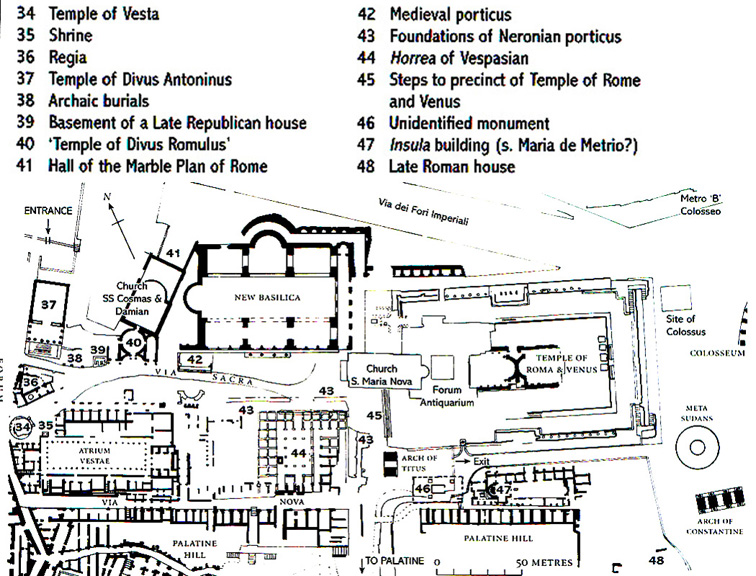Forum Romanum -- Republican
Forum
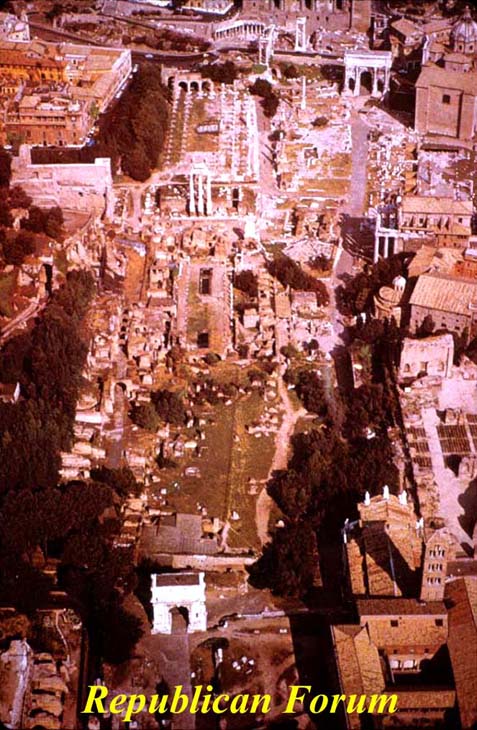
The Forum was the place where anyone who was
anyone in Rome went to see or to be seen. All public and private business
of any import was conducted there, plots could be hatched, friendships
could be made or broken, temples could be visited, assignations could be
arranged or, if you were too busy for that, attentions from several available
genders could be purchased.
Rome started small and the forum did too, but it always was crowded.
And at the height of ancient Rome's population (1.5 million or so in the
immediate urban area), the forum teamed with persons of all stations and
classes and from dawn to well into the night. If you weren't important
enough to go on your own business, you might be dragged along to swell
the entourage of your boss -- it was important for bosses to impress other
bosses by moving about in this center of activity with huge flocks of underlings.
Even underlings had underlings, and they all went to the Forum. Rich kids
(who had underlings of their own) went to the Forum to hang out -- it was
like the shopping malls in rich American suburbs, but on a much grander
scale. The only places more popular were the Colosseum, right at the eastern
end of the Forum, and the Circus Maximus, around the corner of the Palatine,
when games were in progress. And the games were held on non-business days
in the Forum.
There were really several forums in Rome. There was the Republican
forum, usually designated the Forum Romanum and the topic of this piece.
When the Forum Romanum got to crowded to continue to host the vegetable
and meat markets, they were moved to the forum holitarium and forum
boarium, which were closer to the River but still connected to the Forum
Romanum by the Velabrum valley. And, as space got tighter and crowds
bigger, the various "Imperial Forums" were built just north of the Forum
Romanum: Julius Caesar's forum; the forum of Augustus; the forum of Vespasian
(forum of Peace); the forum and market of Trajan; and the narrow forum
of Nerva, sometimes called the forum transitorium because it connected
the seedy Subbura neighborhood to the north with the Forum Romanum.
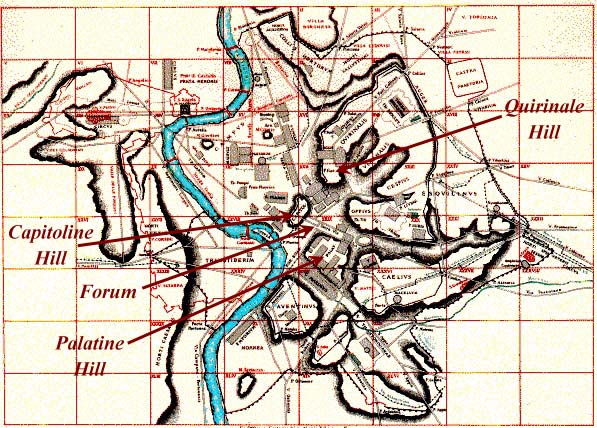
The marshy area that became the Forum Romanum
lay in the depression that separated the Quirinale and Opian hills to the
north from the Palatine to the south. The eastern end of the forum was
crossed by the low Velia ridge that connected the Opian and the Palatine
hills, and the western end of the forum butted up against the base of the
high Capitoline hill. The Velabrum valley between the Capitoline
and Palatine hills connected the Forum to the Tiber River, and it was through
this valley that the waters of the Tiber entered the Forum whenever the
river rose.
The river rose often. In the earliest times, the Capitoline Hill
was sometimes completely surrounded by the waters of the swamp and the
Forum could easily be completely submerged whenever the Tiber crested.
That was all it took to flood the marsh, and the water stayed long. The
Palatine hill was also almost completely surrounded by a very wet marsh.
South
of the Palatine, the area where the Circus Maximus was later built was
mostly submerged, and there was marsh to the east of the Palatine and a
small lake in a depression where the Colosseum now stands. The only dry
connection between the Palatine and nearest high ground, the Opian Hill,
was that Velia ridge.
People lived on the hilltops, and, when it was dry enough to do so,
they traded in the lower, neutral territories, especially in the slopes
of the Velia ridge facing westward into what eventually became the Forum
Romanum. A few early temples, including the all-important Temple of Vesta
housing the sacred fire, were built on the Velia slope, and that end of
the forum valley acquired the religious character that it would always
have.
To understand how the central area of the forum got its commercial
role, we have to dip into Roman history/mythology. The beginning of Rome
found Romulus and his band of outlaws (he actively recruited them) on the
Palatine Hill. They had already downed Remus, whose band was on the Aventine
Hill south of the Circus Maximus valley. Although the Roman "founding myths"
say that Romulus and Remus were descended from the Trojan Aeneas through
kings of Alba Longa, the names Romulus and Remus are actually Etruscan.
Many experts say that Romulus and Remus were simply Etruscan outlaws or
outcasts, who may or may not have been related -- descriptions of them
as twins, in other words, might just have meant that they were similar
and equally matched, and the founding myths were embellished later to give
an appropriate heritage to Romans and especially to the Julian line that
had paid Vergil to write up the Aeneas legend as an epic.
There were Sabine groups on the Quirinale and Opian Hills, and the
opposite, western shore of the Tiber River was Etruscan as was most of
the territory north of Rome. Tiber Island, on which the earliest evidence
of settlement in the area was found, changed hands often. Latin tribes
-- cousins of the Sabines -- filled most of the area just south of Rome.
The story of Romulus getting the Sabine men drunk and stealing and
raping their virgin daughters is well known, as is the sequel: the girls
just loved being so mistreated and interceded to stop the war between their
parents and their new "husbands", the Roman outlaws. Once neighborhood
peace was assured, regular trade between the Sabines and Romans and, eventually,
a summer market were established in the forum valley. And within a few
generations Etruscan kings had taken the Roman monarchy and brought their
formidable engineering skills to bear to drain the valley and make the
forum an all-season market. First, open sewers (cloacae in Latin)
were dug, and, during the reign of the last Etruscan monarch, Tarquinius
Superbus (Tarquin the Proud), the great covered sewer, the cloaca maxima,
was installed. The river still rose often, flooding the forum and the Campus
Martius, north of the Capitoline Hill, but the cloaca maxima quickly
drained the water from the forum back into the Tiber. Over the centuries,
dikes were built along the River to limit flooding, but the cloaca maxima
was what made the Forum useable.
Meanwhile, the Capitoline Hill had achieved a dual function. The
lower of its twin peaks became the templum or dedicated ground for
the Temple of Jupiter. The higher peak was the Arx from which the Augurs,
priests whose job it was to interpret the flight of birds, could announce
their findings. The only road up to the Capitoline was the Clivus Capitolinus,
meaning Capitoline ramp, up from the Forum. At the base of that ramp, in
the area near where the Arch of Septimus Severus was later built, the Romans
gradually established the buildings and structures associated with their
civil government. There was a curia or Senate chamber (on a slightly
different axis than the one we see now that Julius Caesar started) and
in front of the curia was the circular comitia platform on
which the comitia tibuta -- a legislative assembly of the people,
organized on a tribal basis -- met. The edge of the comitia platform
facing the forum was the tribunal, so named because the tribunes
of the people spoke there. The side of the tribunal facing out into the
Forum was eventually decorated with the bronze ramming beaks (rostra)
of captured enemy warships, and speaking to the mob from the rostrum became
the habit of politicians and demagogues. Behind the Clivus Capitolinus,
along the side of the Capitoline hill facing the Forum, the Romans built
their Tabularium where the "Twelve Tables" of Roman law and other
civic and legal documents were kept.
And so, there was the Forum Romanum with three sections: the civil
government on the western end, the food market in the center, and the religious
area centered on the cult of the Vestals on the eastern end. This tripartite
plan had appeared haphazardly, so there was little resistance to its gradual
dissolution. Over the 1000 plus years of ancient Rome's power -- from 723
BC, the mythical year of Rome's founding, through 330 AD, when Constantine
decamped with his government for Constantinople -- the forum became a hodgepodge
of interspersed civic and religious structures. The food stalls and trinket
shops were soon expelled to sites closer to the riverbank in the forum
boarium and the forum holitarium. New temples were built wherever
there was space in the Forum. Vast basilicas were built along the
sides, in which government officials and private individuals could conduct
legal and civil business and law.
Already by the end of the Republic, the Forum Romanum had become
so crowded that Julius Caesar (and succeeding Emperors) could justify massive
expenditures for northward expansions that became the Imperial Forums,
but, meanwhile, any open spaces in the forum were targets for installations
of temples, dedicatory columns, and statues. The forum glittered with gold
and shiny new bronze and flashed with color -- remember that many statues
were painted, and all of the frescoes and paintings were bright and new.
After Constantine took the government to the eastern Mediterranean
the Forum, like the rest of Rome, went into rapid decline. Within a few
hundred years rubble, trash, and flood-born soil had raised the surface
level in the forum area by several meters, vegetables were grown and sheep
and cattle grazed where the great of Rome had once strode. The tops of
ruined ancient monuments jutted up and provided support and foundations
for much meaner structures as well as inspiration for centuries of artists.
Even when Rome was gradually repopulated beginning in the 14th century,
there was no interest in the Forum ruins except as quarries for pre-made
pillars, and for stone and lime for new construction. Look for the deep
grooves near the tops of the columns on the porch of the Temple of Antoninus
and Faustina: they are from cables Renaissance looters used while trying
to jerk the pillars out of the ground for reuse elsewhere. Michelangelo
carved a step from the temple of Castor and Polux to make the base he put
under the ancient statue of Marcus Aurelius in the Campidoglio. Stone from
the top levels of the Forum is all over Rome, and only the depth of the
debris cover kept the rest from disappearing.
Nineteenth and 20th century archeology, continuing into the 21st,
has revealed what we see today. We can only hope that the situation in
the area never deteriorates again to a level where the now exposed ruins
are again seen, not as valued monuments to the past, but as raw construction
materials.
Below -- Republican Forum, NorthWestern end
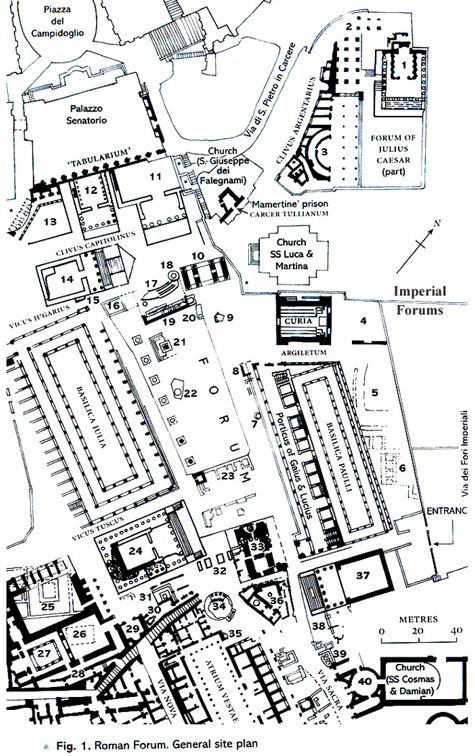
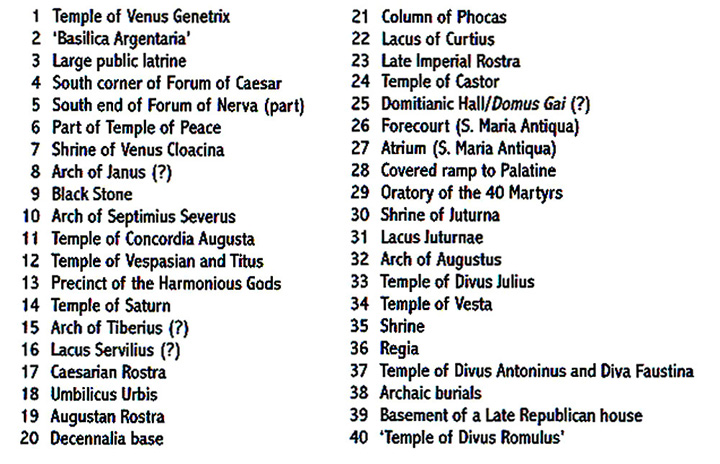
Below -- Republican Forum, SouthEastern end
